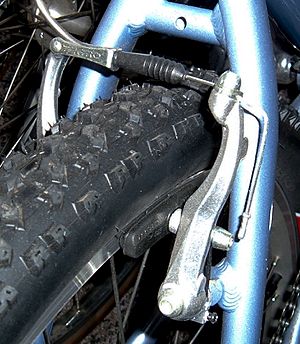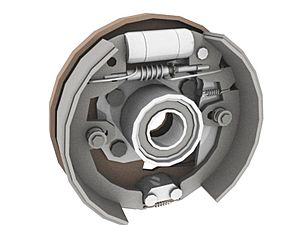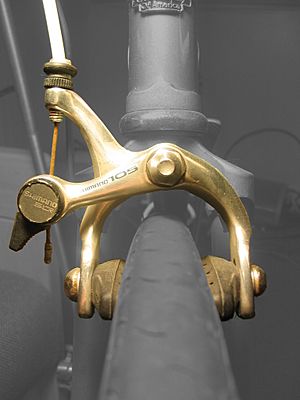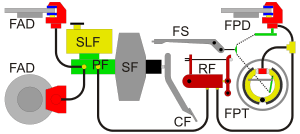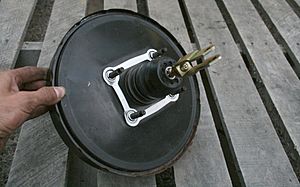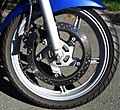Brake facts for kids
A brake is a special device that helps to slow down or stop a moving part of a machine. The most common brakes are found on wheels, like those on cars and bicycles. Brakes are very important for safety!
Contents
How Brakes Work
Brakes work in different ways. They can use friction, pumping, or electromagnetism. Sometimes, a brake might even use a mix of these methods!
Friction Brakes
Friction brakes are the most common type. They work by rubbing two surfaces together. This rubbing creates friction, which slows things down. Think of rubbing your hands together to make them warm – that's friction!
There are two main kinds of friction brakes:
- Drum Brakes: Imagine a spinning drum. Inside, there are curved parts called brake shoes. When you press the brake, these shoes push outwards and rub against the inside of the drum. This rubbing slows the drum and the wheel down. Drum brakes are often found on older cars or the back wheels of some newer, less expensive cars. They can get hot and wear out faster than disc brakes.
- Disc Brakes: These brakes use a flat, spinning disc, often made of metal. When you press the brake, special pads squeeze the disc from both sides. This squeezing creates friction, which slows the disc and the wheel. Disc brakes are very common on modern cars and bicycles because they work well and cool down faster.
Pumping Brakes
Pumping brakes use a pump to slow things down. For example, some big trucks use their engine to help brake. When the driver stops giving the engine fuel, the engine's own pumping action helps to slow the truck. This is like trying to push air through a small opening – it takes effort and slows things down.
Electromagnetic Brakes
Electromagnetic brakes use electricity and magnets to slow things down. They don't use rubbing parts like friction brakes. Instead, they create a magnetic force that resists movement.
For example, some hybrid cars use their electric motor as a brake. When the car slows down, the motor acts like a generator, making electricity and slowing the car at the same time. This electricity can even recharge the car's batteries! Some trains also use electromagnetic brakes to create heat and slow down.
Brake Features
Brakes have different features that make them good for different jobs:
- Stopping Power: This is how much force a brake can use to slow something down. A brake with high stopping power can make a car stop very quickly.
- Heat Resistance: Brakes get hot when used a lot. Good brakes can handle a lot of heat without losing their power. If they get too hot, they might "fade" and not work as well.
- Smoothness: A good brake works smoothly. It doesn't grab suddenly or make the vehicle jerk. This helps prevent skids and makes the ride comfortable.
- Durability: This means how long the brake parts last before they need to be replaced. Brake pads and discs wear out over time.
- Weight: Brakes add weight to a vehicle. Lighter brakes can help a vehicle move faster or use less fuel.
- Noise: Brakes can sometimes make noise, like a squeal or grinding sound. This can be a sign that the brake pads are wearing out.
Brake Boosters
Most modern cars have a "brake booster." This is a special device that helps you push the brake pedal. It uses the engine's vacuum to make your foot pressure much stronger. This means you don't have to push as hard to make the car stop.
If the engine is running very fast, the brake booster might not get enough vacuum, making the brakes feel weaker. This is why drivers usually take their foot off the gas pedal before pressing the brake.
Brake Noise
When brakes work, they turn the moving energy of a vehicle into heat. But sometimes, they also turn some of that energy into sound. This can cause noise, like squealing or grinding. These noises can sometimes tell you that your brakes need to be checked.
Brake Fires
Sometimes, if brakes on a train or other large vehicle get too hot or malfunction, they can create sparks. These sparks can sometimes cause fires, especially in dry areas like forests.
Energy Loss
Every time you use your brakes, some energy is lost as heat. Even special "regenerative braking" systems, which try to save energy, can't save all of it. So, if you want to use less fuel in a car, try to brake less often. This means driving smoothly and looking ahead to avoid sudden stops.
Images for kids
-
Disc brake on a motorcycle
See also
 In Spanish: Freno para niños
In Spanish: Freno para niños


